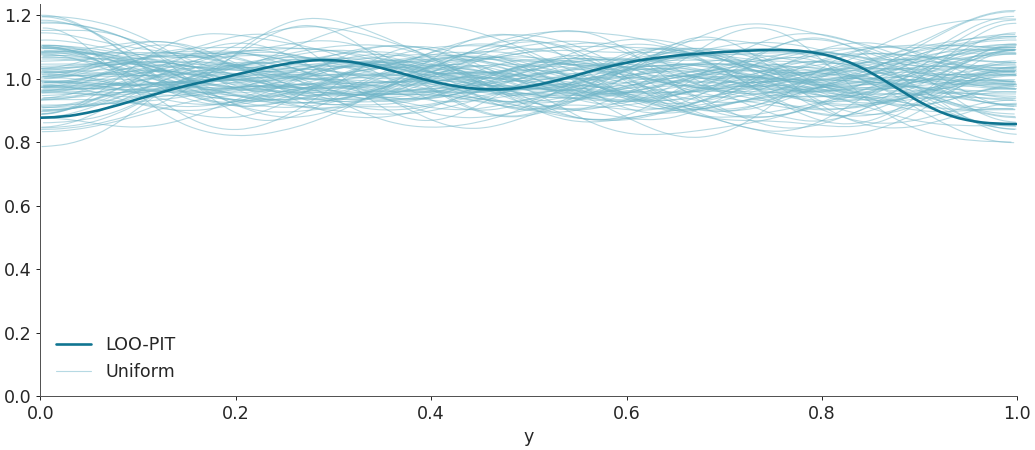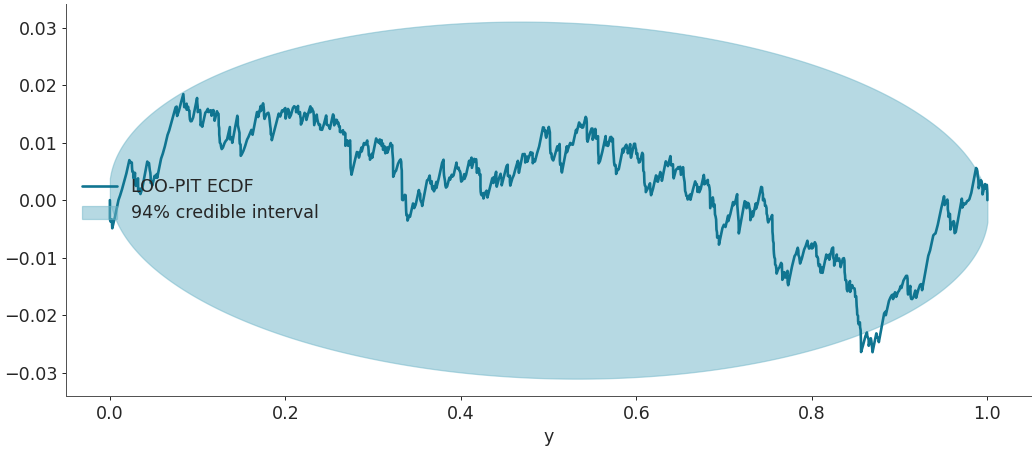arviz.plot_loo_pit#
- arviz.plot_loo_pit(idata=None, y=None, y_hat=None, log_weights=None, ecdf=False, ecdf_fill=True, n_unif=100, use_hdi=False, hdi_prob=None, figsize=None, textsize=None, labeller=None, color='C0', legend=True, ax=None, plot_kwargs=None, plot_unif_kwargs=None, hdi_kwargs=None, fill_kwargs=None, backend=None, backend_kwargs=None, show=None)[source]#
Plot Leave-One-Out (LOO) probability integral transformation (PIT) predictive checks.
- Parameters:
- idata
InferenceData arviz.InferenceDataobject.- y
array,DataArrayorstr Observed data. If str,
idatamust be present and contain the observed data group- y_hat
array,DataArrayorstr Posterior predictive samples for
y. It must have the same shape as y plus an extra dimension at the end of size n_samples (chains and draws stacked). If str or None,idatamust contain the posterior predictive group. If None,y_hatis taken equal to y, thus, y must be str too.- log_weights
arrayorDataArray Smoothed log_weights. It must have the same shape as
y_hat- ecdfbool, optional
Plot the difference between the LOO-PIT Empirical Cumulative Distribution Function (ECDF) and the uniform CDF instead of LOO-PIT kde. In this case, instead of overlaying uniform distributions, the beta
hdi_probaround the theoretical uniform CDF is shown. This approximation only holds for large S and ECDF values not very close to 0 nor 1. For more information, seeVehtari et al. (2021), Appendix G.- ecdf_fillbool, optional
Use
matplotlib.axes.Axes.fill_between()to mark the area inside the credible interval. Otherwise, plot the border lines.- n_unif
int, optional Number of datasets to simulate and overlay from the uniform distribution.
- use_hdibool, optional
Compute expected hdi values instead of overlaying the sampled uniform distributions.
- hdi_prob
float, optional Probability for the highest density interval. Works with
use_hdi=Trueorecdf=True.- figsize(
float,float), optional If None, size is (8 + numvars, 8 + numvars)
- textsize
int, optional Text size for labels. If None it will be autoscaled based on
figsize.- labellerLabeller, optional
Class providing the method
make_pp_labelto generate the labels in the plot titles. Read the Label guide for more details and usage examples.- color
stror array_like, optional Color of the LOO-PIT estimated pdf plot. If
plot_unif_kwargshas no “color” key, a slightly lighter color than this argument will be used for the uniform kde lines. This will ensure that LOO-PIT kde and uniform kde have different default colors.- legendbool, optional
Show the legend of the figure.
- ax
axes, optional Matplotlib axes or bokeh figures.
- plot_kwargs
dict, optional Additional keywords passed to
matplotlib.axes.Axes.plot()for LOO-PIT line (kde or ECDF)- plot_unif_kwargs
dict, optional Additional keywords passed to
matplotlib.axes.Axes.plot()for overlaid uniform distributions or for beta credible interval lines ifecdf=True- hdi_kwargs
dict, optional Additional keywords passed to
matplotlib.axes.Axes.axhspan()- fill_kwargs
dict, optional Additional kwargs passed to
matplotlib.axes.Axes.fill_between()- backend
str, optional Select plotting backend {“matplotlib”,”bokeh”}. Default “matplotlib”.
- backend_kwargsbool, optional
These are kwargs specific to the backend being used, passed to
matplotlib.pyplot.subplots()orbokeh.plotting.figure(). For additional documentation check the plotting method of the backend.- showbool, optional
Call backend show function.
- idata
- Returns:
- axes
matplotlib Axesorbokeh_figures
- axes
See also
References
Gabry et al. (2017) see https://arxiv.org/abs/1709.01449
Gelman et al. BDA (2014) Section 6.3
Examples
Plot LOO-PIT predictive checks overlaying the KDE of the LOO-PIT values to several realizations of uniform variable sampling with the same number of observations.
>>> import arviz as az >>> idata = az.load_arviz_data("radon") >>> az.plot_loo_pit(idata=idata, y="y")

Fill the area containing the 94% highest density interval of the difference between uniform variables empirical CDF and the real uniform CDF. A LOO-PIT ECDF clearly outside of these theoretical boundaries indicates that the observations and the posterior predictive samples do not follow the same distribution.
>>> az.plot_loo_pit(idata=idata, y="y", ecdf=True)


